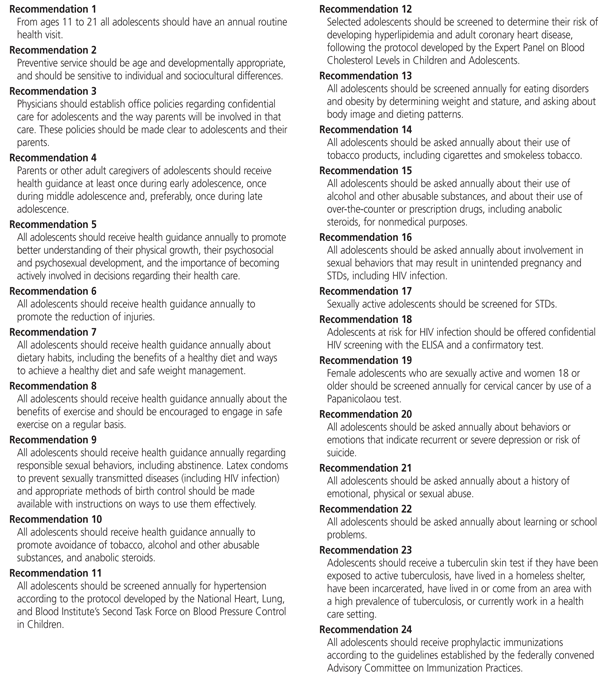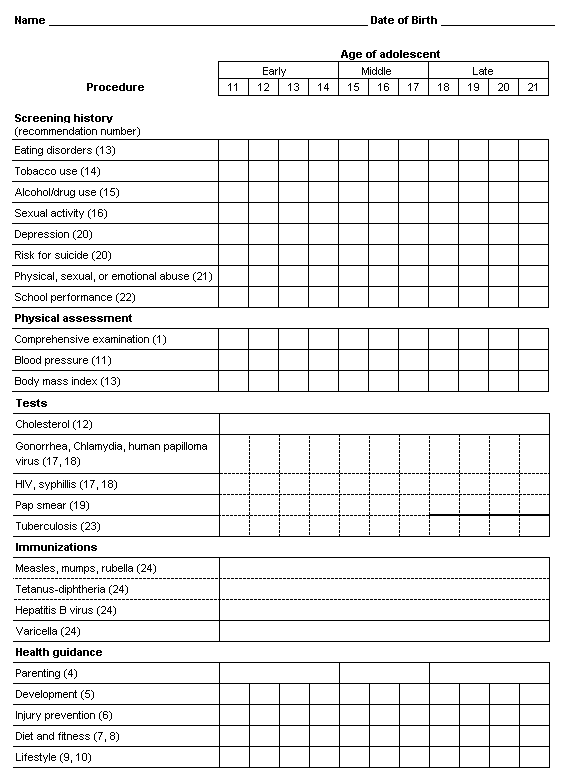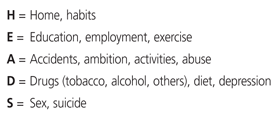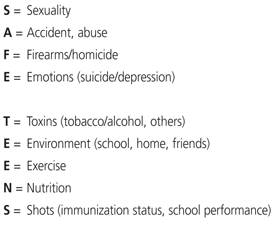
Am Fam Physician. 1998;57(9):2181-2188
A more recent article on screening and counseling adolescents and young adults is available.
See related patient information handout on health care for teenagers, written by the author of this article.
The Guidelines for Adolescent Preventive Services (GAPS) include recommendations developed and promoted by the American Medical Association's Department of Adolescent Health and are intended to organize, restructure and redefine health care delivery for 11- to 21-year-old patients. Data show that health risks in this age group are more social in origin than medical, and that these unhealthy behaviors can be recognized and interventions can be applied at an earlier age to reduce adolescent mortality and morbidity. In fact, evidence suggests that some interventions may result in a decrease in premature adult mortality. GAPS provides physicians with preventive service recommendations and a flow sheet that is useful for implementing and documenting these services during office visits. This system enables the busy physician to identify at-risk adolescent patients and provide them with information about changing unhealthy behaviors.
Family physicians are primarily responsible for most of the medical care delivered to adolescents in the United States today. Applying the Guidelines for Adolescent Preventive Services (GAPS) is one way for physicians to structure the delivery of care to these unique and challenging patients.
Guidelines for Adolescent Preventive Services
GAPS was first published in December 1993.1 Members of various interdisciplinary organizations provided input, and the development of these guidelines was promoted by the American Medical Association's Department of Adolescent Health and the Centers for Disease Control and Prevention. Nationally, the promotion of adolescent preventive services has been recommended by numerous authorities, including the Bright Futures2 project sponsored by the Maternal and Child Health Bureau, the Put Prevention Into Family Practice3 office-based program sponsored by the Office of Disease Prevention and Health Promotion, and the American Academy of Pediatrics.4 The United States Preventive Services Task Force published an updated version of its recommended interventions for 11- to 24-year-old patients in 1996.5 All of these organizations suggest similar preventive services.
GAPS consists of 24 recommendations (Figure 1) that encompass health care delivery (recommendation 3), health guidance (recommendation 7), screening (recommendation 13) and immunizations (recommendation 24). The goal of GAPS is to improve health care delivery to adolescents using primary and secondary interventions to prevent and reduce adolescent morbidity and mortality.

Decisions about ways to apply GAPS during interactions with adolescents in the office setting are the responsibility of the physician. The use of GAPS enables the physician to restructure the visit from a focus on traditional assessment of wellness to identification and treatment of at-risk behaviors such as drinking, unprotected sex, nicotine use or thoughtless/careless approaches to life. Historically, traditional medical care for adolescents has produced much smaller decreases in morbidity and mortality when compared with traditional medical care in other age groups. This finding is related to the fact that rates of injury and violence are higher today than they were 50 years ago.6,7
Three out of four adolescent deaths are caused by unintentional injury (e.g., motor vehicle accidents, drownings, poisonings, burns) and violence (e.g., homicide, suicide).8,9 This finding provides evidence that most mortality in adolescents and young adults may be attributed to unhealthy or risky behaviors. In 1993, approximately three fourths of adolescent deaths were considered preventable.5
The 1995 Youth Risk Behavior Surveillance Survey, a national survey of students in grades nine through 12, revealed that 72 percent of all deaths among school-aged youth were the result of four primary causes: motor vehicle accidents, other unintentional injury, homicide and suicide.10 Similar data from patients five to 21 years of age identified the same causes of mortality,11 indicating a need for physicians to focus on accidents and violence in preventive care.
There has been some success in reducing teenage mortality. The overall death rates for persons from 10 to 24 years of age decreased 11.7 percent from 1979 to 1988. “Other injury” and motor vehicle crashes (35.7 percent and 15.5 percent, respectively) both declined but were offset by an increase in absolute rates of suicide and homicide (7.9 percent and 6.7 percent).8
From 1979 to 1991, mortality from all causes in 15- to 24-year old young people decreased by 12.8 percent, and unintentional injuries decreased by 32.9 percent. Absolute increases in homicide and suicide (54.5 percent and 5.6 percent, respectively) indicate that prevention in these areas should be emphasized.12
A critical review of the GAPS recommendations raised questions regarding the strength of the evidence supporting the efficacy of physician-based interventions.13 The U.S. Preventive Services Task Force noted that the effects of some interventions on adolescent behavior are unproved.5 This article provides physicians with a simplification of the GAPS recommendations so that they can offer preventive services with increased ease, efficiency and consistency.
Free copies of the GAPS recommendations can be obtained by contacting the American Medical Association, Department of Adolescent Health, 515 North State St., Chicago, IL 60610; telephone: 312-464-5570; order no. NL01892.
GAPS Theory and Rationale
The rationale behind the development of GAPS is the belief that high-risk behaviors and negative lifestyle patterns can be identified at an early age and that interventions can reduce premature morbidity and mortality while the patient is a teenager (and possibly as an adult). These preventive services and educational opportunities may be the most cost-effective in this age group, although further research is necessary.
The large number of GAPS recommendations and the various ways to implement them can present a challenge to the physician. However, identification of adolescent concerns or problems is vital to developing and instituting appropriate intervention strategies. Strategies may include counseling, providing basic information or self-help literature, and scheduling follow-up visits or referrals. The use of GAPS may help the physician identify important health-related behaviors before they manifest as illness or injury.
Using the GAPS Health Service Record
Many physicians use flow sheets to improve chart organization and facilitate consistent provision of longitudinal care. The GAPS Health Service Record (GAPS-HSR) is an ideal method for recalling and applying GAPS recommendations to adolescent patients (Figure 2). It provides a method of recording services rendered, information on each guideline and the age at which they should be applied.

Three recommendations address the delivery of services to adolescents and provide the basis for the GAPS recommendations. The first recommendation provides for annual preventive services for 11- to 21-year-old patients. The second recommendation states that the preventive services offered should consider the age of the adolescent and provide culturally and developmentally appropriate information as it relates to each patient individually. The third recommendation is that physicians develop, establish and document office policies that address issues of confidentiality and indicate how parents will be involved in the care of their child. It is important that both parents and adolescents be aware of and understand these policies.
Once guidance is provided, the screening history is performed, the appropriate physical examination is completed, laboratory values are checked and immunizations are administered, a date is entered in the space that corresponds to the recommendation. There are some incomplete areas (dashed lines) on the GAPS-HSR, indicating that the patient's screening history and/or the physician's clinical judgment should be considered before these tests or immunizations are administered. For example, a 14-year-old male basketball player who is not sexually active does not require the same history or judgment decisions as a 17-year-old female who is sexually active and homeless.
Reviewing the GAPS-HSR before seeing the patient for acute or follow-up appointments can give the physician more time to assess or follow up on missed recommendations. Alternatively, the physician may suggest that the office staff screen the adolescent and make notes on the GAPS-HSR; then the physician can reinforce or review these areas, if necessary. As with all forms, physicians should adapt this form to their own needs to improve efficiency and management.
Illustrative Case
A 17-year-old female presented to a family physician after being referred by a hospital emergency department for follow-up of pelvic inflammatory disease. She had a history of tobacco, alcohol and drug abuse, and was sexually active. These details were entered in the appropriate screening area on the GAPS-HSR.
The patient denied having an eating disorder. She also said at this visit that she had dropped out of school. Specifics from the patient's physical examination were recorded in the physical assessment section. Screening tests were performed at this visit because of the patient's sexual risk factors and because the physician feared not being able to maintain follow-up. Immunizations for measles, mumps, rubella and hepatitis B were administered.
Health guidance revealed that no parents were listed. The patient's mental and physical development, attitude toward injury prevention, and lifestyle were of concern to the physician and were detailed on the form. The physician used circles to indicate that depression, suicide and abuse were not addressed at the initial visit and, in retrospect, this omission was found important. The circles on the form called the physician's attention to this omission, and during a follow-up appointment these topics were given the highest priority and were documented on the form. An arrow was used to indicate that depression and suicide risk were ongoing problems. This patient was subsequently admitted to a hospital after a suicide attempt and was re-evaluated during routine follow-up at every subsequent visit. Notes relating to these events should be written directly on the form.
A year later, the patient indicated that she had stopped using alcohol and drugs but was still sexually active and smoking. She began to develop some body image problems. At the time of this visit, the patient said she had decided to get her GED, which was recorded in the progress notes. Because of her sexual behavior risk, she was retested for sexually transmitted diseases (STDs) and was counseled about the risks associated with smoking and sexual activity, including STDs and the use of contraception.
Important Points About GAPS
Most adolescents will not speak openly if they think that others will find out what they have discussed. Therefore, physicians should reassure these patients by explaining their confidentiality policy. Explaining your approach to patient confidentiality at an initial office visit can reinforce your policy covering the way sensitive topics will be handled and ease the tension before any discussions begin. Laws governing the issue of confidentiality vary from state to state, and physicians should be aware of these regulations.
In addition to communication skills, the physicican needs to appropriately manage screening tests. Some rescreening may be necessary as a natural result of adolescent development (e.g., onset of sexual activity, employment, drug use, participation in sports). Annual visits provide an opportunity for the physican to revisit and update health care in these areas.
Application of Services
Use of several mnemonics may help the busy physician recall many GAPS recommendations. Mnemonics allow for rapid recall of some GAPS recommendations during a routine sports physical or an acute visit and can result in time savings for the physician. The “HEADS” and “SAFE TEENS” mnemonics are the most well known (Figures 3 and 4). In addition to mnemonics, questionnaires for male and female adolescents and their parents have been developed by the authors of GAPS and others to increase efficiency and facilitate health care delivery.14 Ideally, these forms would be completed by the adolescent and his or her parent(s) while they are waiting for the physician and then would be discussed in a prioritized fashion during that visit. This method saves time for the physician and helps to focus the interview on specific patient or parental concerns. Using the GAPS-HSR form will help the physician identify missed screening topics and document services provided.


Physicians may be able to delegate some of the preventive services to office staff. Office personnel can obtain screening information, measure blood pressure, record body mass index, provide health guidance and distribute age-appropriate information. In addition, scheduled laboratory values and immunizations can be highlighted by the staff and ordered, with little time required on the part of the physician. As with other services provided in the office setting, delivery systems should facilitate physician time with the patient, allowing for a more detailed history or for problem-focused health guidance, if required.
Prioritizing Recommendations
In 1995, 65 percent of all adult deaths were caused by heart disease, cancer and stroke. Developers of the Youth Risk Behavior Surveys believe that the behaviors leading to these outcomes in adults were “initiated during adolescence.”10 In general terms, they classify six areas of behavior that result in premature morbidity and mortality. They are: behavior that contributes to unintentional and intentional injuries, tobacco use, alcohol and other drug use, sexual behaviors, unhealthy dietary behaviors and physical inactivity.
The behaviors causing both adult and adolescent mortality are included in the GAPS recommendations. Specifically, these include tobacco use, inadequate use of bicycle and motorcycle helmets, lack of seat belt use, use of marijuana or alcohol, riding in a car with a driver who has used these substances, carrying a weapon, engaging in physical fighting, homicide and suicide. Avoiding drugs, exercising, maintaining an ideal body weight, making proper nutritional choices, and avoiding or delaying sexual activity during adolescence may reduce premature adult mortality. Interventions that identify and target these behaviors may be the most important risk factors for physicians to evaluate.
Final Comment
GAPS recommendations can be applied in a busy clinical practice. By making use of the HSR form, understanding the GAPS recommendations and employing two simple mnemonics, physicians can improve the way they provide adolescent preventive services. Following the GAPS recommendations will enable physicians to increase time spent with these patients. In addition to the immediate benefit adolescent patients may derive from increased communication with their physician, they may also build more constructive and positive relationships with other health care professionals that may promote good health habits and prevent future illness and injury. There may be no other group of patients in our practices where small interventions may have such valuable long-term outcomes.